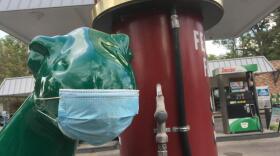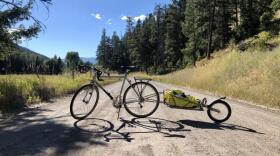Nate Hegyi, rural reporter for the Mountain West News Bureau, is embarking on a 900-mile cycling trip crisscrossing the continental divide in August and September, interviewing and listening to Americans ahead of the 2020 election. You can follow along on social media, an and this "Where Is He Now?" map.
September 16-17: Colorado border to Walden, Colorado, 25 miles
An important note here: These are my first-glance takeaways. Think of this as a reporter's notebook. A mosaic of voices over the next few weeks, cycling 900 miles across four states and dozens of small towns.
I’m about three miles from the Colorado border and the sound of nearly a hundred black cattle crying and moving across this high desert valley is overwhelming.
Dust kicks up from the animals’ hooves as men and women on horseback whistle and hoot, keeping them in line. Gray cattle dogs stalk the herd, rushing in and nipping the heels of any stragglers.
I’m at a safe distance recording the commotion. I’ve done enough reporting on ranches and I have enough common sense to not bother these folks while they’re moving cattle.
But damn – they cut an iconic figure: cowboy hats, vests and chaps. One woman has a long, tight brown braid.
The dust rises in the early morning light and cakes them. Some wear pastel bandanas tied around their necks.
This is the first time on this entire trip that I’ve actually seen people working cattle on horseback and it’s thrilling.
As a kid, I was obsessed with cowboys – one humid, Wisconsin summer, I wore the same pair of Wrangler jeans, a red plaid shirt and a black cowboy hat everyday. I nearly wore out my Garth Brooks cassette.
My grandfather, who grew up on a small farm in the prairies of Manitoba, was cut from a similar cloth. He read hundreds of Louis L'Amour and Zane Grey paperback Westerns throughout his life – he’d keep a tally of them in a little notebook.
We aren’t alone. Around the world, the image of the cowboy defines the American West. Sometimes, when I’m riding my bicycle, I pretend it’s a horse – I’m moving across this landscape at about the same speed. Watching these cattle lumber across the highway, I almost want to be a cowboy again, just like I did when I was a kid.
But if I tried to join them I’d be blocked at the fence. The land all around me is untouchable – privately owned by the A Bar A ranch. You see their ‘No Trespassing’ signs all along this valley.

It’s not until I’m well across the state line near Cowdrey, Colorado that their grasp on the earth weakens. Other, smaller ranches and public lands replace them.
Once I get some limited cellular service, I find out that A Bar A, along with three sister ranches owned by the same family, controls nearly 100,000 acres out here. It’s one of the region’s oldest guest ranches.
Lodging costs nearly $600 a night for adults and you can go horseback riding, fly fishing, shooting and hiking on their lands.
This week, according to its website, they are hosting a rendezvous with live music and cattle drives – my heart sinks and I wonder whether those riders I saw were really working cowboys and cowgirls or guests learning the basics.
The working ranchers I’ve met often use all-terrain vehicles to move animals, not horses. I make a note to call the ranch when I return to Missoula to find out.
The ride from the small town of Cowdrey to Walden is a brutal one. The road has no shoulder and semi-trucks twice run me off the road. One has the courtesy to honk before it happens. The other flies by close enough for me to touch it with an outstretched hand. It angers me – why endanger someone’s life like that? I understand that I’m a biker, moving really slowly, and that’s frustrating. But state laws allow it and people have been cycling this same route since the early 1970s.
I make pains to remember that most drivers on this trip have been exceptionally aware, giving me a wide berth. I return the favor when I can, whenever there is shoulder enough for me to hug.
It’s noon by the time I reach Walden, Colorado and I head for a restaurant and bar, ordering yet another hamburger and fries. If my legs don’t give out on this trip then my heart will. But I need the calories.
Looking at myself in the bathroom mirror here, I can see that I’ve lost both weight and my battle against the sun. My nose appears permanently red these days and my brown hands are peeling, despite efforts to use sunscreen regularly.
As I’m eating, I notice the place is filled with working cowboys. Their hair is matted down from their hats. Some have thick goatees. One wears bright yellow boots. They seem deep in conversation so I don’t bother them. The whole town, in fact, seems busy. It’s both hunting season and the fall roundup. “No vacancy” lights are on at most hotels and the restaurants are full. Semi-trucks full of cattle drive by the main drag, the smell of urine and feces wafting into the air. The animals are headed to feedlots, where they will be fattened with grain, slaughtered and eventually grilled on barbecues or eaten at restaurants like this across the country.
After filling my belly, I hightail it to a motel to get started on writing my journal entries – I’ve fallen drastically behind. Most of my notes are handwritten, so my job is to translate them into sensible sentences on my iPad. By the time I’ve completed a couple the sun has already set, and I’ve lost out on any chance to interview someone for today.
My self-prescribed quota for interviewing is roughly three a day – even if some of those are off-record. But today I dropped the ball. I try to forgive myself because I’m also pretty tired and I just want to sleep.
But sleep doesn’t come easily. I wake up early in the morning, sweating under the heavy comforter of the motel bed, so I drink coffee and try to finish my journal entries. After a 9:30 a.m. debrief with the BBC and an edit with my editor, Kate, I pack up my gear and cruise Walden, looking for an interview.
Sometimes these interviews can last as long as an hour. But I’m striking out here. A couple of people politely decline and, just as yesterday, folks seem busy here. I pop my head into a butcher shop where owner Chat Carlstrom is processing elk, antelope and deer for his customers. His hands are covered in blood and he has cool, blue eyes, a baseball hat and some stubble.
Carlstrom says he’s busy right now due to the hunting season, but asks if I can call him on his cell phone later. When I do, he’s driving to a football game in eastern Colorado and can’t talk until next week. For the first time since beginning this trip, I’m skunked – I need to hit the road to reach my camp near Rabbit Ears Pass before sunset, and I haven’t filed any interviews.
But the road quickly assuages my frustration – this is my last afternoon cycling on this journey and I drink it in. It’s fitting that I’m travelling through some of the most beautiful country on this whole adventure. Wildfires are burning east of here near Steamboat Springs and that adds a special quality to the light.
The sky is on fire – orange and hazy – and the aspens are on fire, too, with the yellow of autumn. A common sight in the West at this time of year although this season has been particularly destructive.
As I scan the horizon I see a squat, log cabin sitting high on a nearby hill.
Outside, an American flag and a Trump 2020 flag hang on a pole at nearly equal heights. As I pass, I hear the firecracker pop of a pistol – six times. They aren’t shooting at me. Probably just some target practice. I let the cabin disappear behind me as the road climbs towards Rabbit Ears Pass and the continental divide. As dusk overtakes the day, I find a forest service road to make camp on. When I take off my socks, dust and salt shake off like dirt. I decide to sleep underneath the stars, watching a jet float silently by.
I’m nostalgic. Life slowed down for nearly a month and America was cracked slightly open. Like a rock hiding a geode, I caught glimpses of her.
This country is a hell of a place to live in. I’ve only biked 750 miles across it, through a pocket of the American West, and I’m in awe of its diversity. The land morphs from desert to alpine forest over a matter of miles. Mountains erupt and disappear.
But the people – my God, the people!
I’ve met everyone from a saddle shop owner to hitchhiking musicians to a fly fisherwoman to African mormons to truck drivers to a wheelchair karate expert to a Trump-supporting knife craftsman to a Hispanic oil worker to a punk rock sous chef. Each understands America and the West differently – their views informed by lifetimes of pain, family, open country and wild places.
If there’s any conclusion I’m coming to now that this journey is nearing its end, it’s that I don’t understand how America has worked for this long. It doesn’t feel like a country of shared values. It’s an unwieldy quilt — each community stitched to the other but some are colored and sized differently.
Now forces are trying to pull the quilt apart, yanking at the threads until they fray.
Copyright 2020 Boise State Public Radio News. To see more, visit Boise State Public Radio News.







